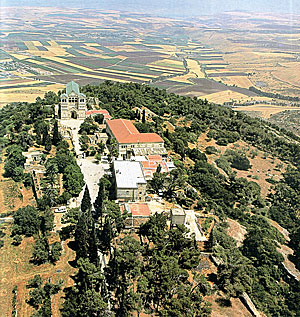Mount Tabor
 |
Picture gallery: Basilica of the Transfiguration Garden (234kb) | overview (205kb) | Basilica (204kb) | Nave (145kb) | Upper/lower Chancel (158kb) | lower Chancel (216kb) | upper Chancel (273kb).
TABOR - 1. A town in the tribe of Zebulun, given to Levites descended from Merari, 1 Ch.6.77. It is perhaps modern Kh. Daburah, near Mount Tabor.
2. A place near Ophrah, Jg.8.18.
3. The Oak (AV 'plain') of Tabor was on the road from Ramah S. to Gibeah, 1 S.10.3.
4. See next article.
TABOR (MOUNT) - A mountain in the NE. corner of the plain of Esdraelon, some 7 miles E. of Nazareth. Though only 1843 feet high, Tabor is, from its isolation and remarkable rounded shape, a most prominent object from great distances around; hence, though of much less size than the great mountain mass of Hermon (9232 feet high and 25 miles long), it was associated with it in popular thought (Ps.89.12). In Jer.46.18 Nebuchadrezzar towers above men ' like Tabor among the mountains, and like Carmel by the sea.' Its Arabic name to-day is Jebel et-Tor, 'the mountain of the mount.' From its summit a magnificent outlook is obtained, especially to the W., over the plain of Esdraelon to the mountains of Samaria and Carmel.
It was on the common frontier of Zebulun and Issachar (Jos.19.12, 22); it was an early sanctuary (Hos.5.1), being probably the mountain where peoples are convoked and right sacrifices offered in Dt.33.19. Here Barak mustered his forces before giving battle to Sisera (Jg.4.6, 12, 14); here, too, in Gideon's day there was a clash between Midianites and Israelites (Jg.8.18). In later history Tabor figures mainly as a stronghold. In 218 BC Antiochus III. captured the city of Atabyrion on Tabor and fortified it. It was in Jewish hands from c 105 BC to the end of the Hasmonaean regime. Here in 53 BC Gabinius defeated the insurgent Alexander, son of Aristobulus II. In AD 66 Josephus fortified the hill against Vespasian, but it surrendered after the defeat of the Jewish troops by Placidus. During the Crusades it was for long in the hands of the Christians, but it fell to the Muslims after the battle of Hattin (1187), and was fortified in 1212 by Saladin's successor - a step which led to the abortive Fifth Crusade. At Mount Tabor Napoleon defeated a Turkish army in 1799.
The tradition that Tabor was the mountain of the Transfiguration has little evidence in its favour, although it is quite early. Its earliest form is that found in the 2nd-cent. 'Gospel according to the Hebrews,' where Jesus says: 'Even now my mother the Holy Spirit took me by one of my hairs and carried me up to the great mountain Tabor' - but this may be in origin an embellished variant of one of the Temptation incidents. Tabor was probably an inhabited spot at the time of Christ, while the requirements of the Biblical narrative of the Transfiguration (Mk.8.27, 9.2-10 and parallels) are met rather by a site near Caesarea Philippi, such as an isolated spur of Hermon.
Mount Tabor to-day is a well-wooded spot, groves of oaks and terebinths not only covering the hillsides but extending also over a considerable area of hill and valley to the N.; game abounds in the coverts. On the summit the Greek Church has a monastery and the Franciscans have the Basilica of the Transfiguration, with a hospice attached. The Franciscans in particular have carried out extensive excavations; the foundations of a great wall of circumvallation have been traced, many ancient tombs have been cleared, and the remains of several churches of the 4th and 12th cent. have been unearthed.
[Article: Dictionary of the Bible, J.Hastings, 2nd Ed., T&T.Clark, 1963 - E.W.G.M. - F.F.B.]